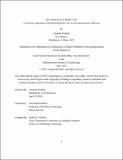| dc.contributor.advisor | Reinhart, Christoph | |
| dc.contributor.author | Kirkeby, Amanda | |
| dc.date.accessioned | 2024-10-16T17:43:12Z | |
| dc.date.available | 2024-10-16T17:43:12Z | |
| dc.date.issued | 2024-05 | |
| dc.date.submitted | 2024-10-10T15:17:09.219Z | |
| dc.identifier.uri | https://hdl.handle.net/1721.1/157333 | |
| dc.description.abstract | Carbon emissions are driving the planet out of its delicate Goldilocks balance. Evidence and the call-to-action date back to 1896 with Swedish scientist Svante Arrhenius and his seminal paper that first predicted the effect of carbon dioxide on the global temperatures. With the Intergovernmental Panel on Climate Change (IPCC) goal of global net zero emissions by 2050, the urgency is stronger than ever. An ever-growing number of municipalities are setting pledges to do their part, often without a concrete plan. With buildings accounting for 40% of total global emissions, building retrofits are a key component to these pathways to zero carbon. Urban building energy modeling (UBEM) research efforts have developed physics-based decision-making tools to define city-scale technology pathways to reach climate goals. However, a crucial question in making these pathways actionable has been largely neglected: how much does it really cost? The scarcity of contemporary cost data and methods for cost prediction at the urban scale makes this question difficult, and further questions around equitable incentive programs nearly impossible to answer. This work demonstrates the concept and relevance of implementing a dynamic cost model in the UBEM context. Several cost models are applied to a case study of 13,000 residences in Oshkosh, WI to predict costs for homeowners to retrofit their homes with three different upgrade packages. A willingness to pay analysis is then performed with upfront cost predictions from different models, illustrating the impact a more robust cost model may have in providing more realistic predictions of an upgrade strategy’s techno-economic success. Through its compatibility with existing UBEM frameworks and local input costs, the dynamic building upgrade cost model hosts the potential to further support municipalities in developing economically feasible building retrofit strategies for decarbonization pathways. | |
| dc.publisher | Massachusetts Institute of Technology | |
| dc.rights | In Copyright - Educational Use Permitted | |
| dc.rights | Copyright retained by author(s) | |
| dc.rights.uri | https://rightsstatements.org/page/InC-EDU/1.0/ | |
| dc.title | How Much Does It Really Cost? A Dynamic Approach to Building Retrofit Costs for Decarbonization Pathways | |
| dc.type | Thesis | |
| dc.description.degree | S.M. | |
| dc.contributor.department | Massachusetts Institute of Technology. Department of Architecture | |
| dc.identifier.orcid | https://orcid.org/0000-0001-6411-0223 | |
| mit.thesis.degree | Master | |
| thesis.degree.name | Master of Science in Building Technology | |
